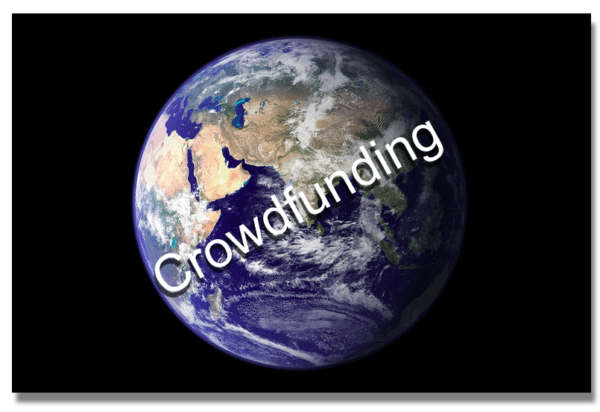Innovation means creating something that makes a process or product more efficient. The result can be a price reduction passed on to consumers in the short run, or an increase in the speed at which a business operates. Ultimately, innovation serves as the backbone to overall economic and societal growth and can elevate standards of living. Today, equity crowdfunding is a one of these innovations.
A global problem identified and uncontested by a majority of economists is the gap between rich and poor both nationally, and even more starkly, globally. Unfortunately, the expansion of technology may actually magnify this gap. Large populations around the globe reside in under-developed economies where approximately 3 billion people live in poverty. Struggling economies are finding it more onerous to compete in the age of globalization because of the lack of infrastructure and know-how to keep pace with technology improvements. Two factors for the income disparity are the lack of knowledge transfer from trade coupled with an uneducated populace. While these aren’t the sole reasons, they do highlight the barriers to entry experienced by local as well as national economies and the limited prevalence and adoption of new technological innovations.
In the United States, the middle class is not achieving quality income growth. According to a New York Times article and statistics from the Bureau of Economic Analysis, the United States has experienced an overall decline in the median annual income of middle class households since 1967. In the 1960’s, 50% of U.S. households were classified as middle class, meaning they earned between $35,000 and $100,000. Now only 43% are part of this group. While many households have moved up the ladder to the upper-class designation, the gap between the growth trajectories of both income classes has increased.
 In an interview with John Gosier, an investor, data-scientist, and serial tech entrepreneur, from Wired.com, the future of equity crowdfunding and its potential global impact is discussed in bold relief. Crowdfunding allows individuals to pledge capital to virtually anything, whether it be to support a social cause like bringing food to the less fortunate or funding a company that creates technology that improves energy efficiency in the United States or in countries with depressed economies. Mr. Gosier touches on the fact that while the global economy has grown tremendously since the beginning of the computer age, the boon in technology innovation has contributed to wealth gaps between the richest and poorest countries. Crowdfunding can be a new powerful tool to help the less fortunate and help expand the quality of life globally.
In an interview with John Gosier, an investor, data-scientist, and serial tech entrepreneur, from Wired.com, the future of equity crowdfunding and its potential global impact is discussed in bold relief. Crowdfunding allows individuals to pledge capital to virtually anything, whether it be to support a social cause like bringing food to the less fortunate or funding a company that creates technology that improves energy efficiency in the United States or in countries with depressed economies. Mr. Gosier touches on the fact that while the global economy has grown tremendously since the beginning of the computer age, the boon in technology innovation has contributed to wealth gaps between the richest and poorest countries. Crowdfunding can be a new powerful tool to help the less fortunate and help expand the quality of life globally.
 Mr. Gosier argues that a tech underclass is developing in which certain technologies only reach certain income levels and countries. This means countries and individuals must find ways to expand innovation to provide technological tools across borders so everyone can benefit from the prospect of innovation. In countries such as the United States, New Zealand, South Korea, and Canada, along with the European Union, equity crowdfunding has begun to gain traction as an alternative investment tool along with donation based crowdfunding. Crowdfunding could spur waves of investment into emerging countries through social causes and start-ups, which in turn creates an ethos of welcoming innovation.
Mr. Gosier argues that a tech underclass is developing in which certain technologies only reach certain income levels and countries. This means countries and individuals must find ways to expand innovation to provide technological tools across borders so everyone can benefit from the prospect of innovation. In countries such as the United States, New Zealand, South Korea, and Canada, along with the European Union, equity crowdfunding has begun to gain traction as an alternative investment tool along with donation based crowdfunding. Crowdfunding could spur waves of investment into emerging countries through social causes and start-ups, which in turn creates an ethos of welcoming innovation.
One way crowdfunding has benefited developing nations is through a product called Gravity Light, which was created as a solution to the 20% of the world’s population that does not have access to electricity. The goal of raising $55,000 to fund the venture ended up bringing in $399,590, a 726% oversubscription, showing the powerful effects of simply using online platforms that allow any individual to pledge capital. The device does not need sunlight or electricity to run making it extremely economical for an impoverished population. The impact of something as simple as a sustainable light source can change the lives of a family without access to electricity.
 An example of how a relatively simple innovation from a small cadre of dedicated individuals can make a huge impact was in Egypt during the Arab Spring. During this time period Internet and phone lines were completely shut off or blocked, meaning communication was impossible. But Mr. Gosier’s venture Abayima allowed for communication between cellphones without the need of a SIM card, a usually integral component in cellular communication. During the same in time the country of Uganda, it was election season and candidates were looking for any way to bring in votes. The government decided to block various words and statements sent over text message SMS like “dictator” or “Put him out of power.” In countries throughout Africa and in other developing world nations, mobile communication is key to spreading news and communicating to the outside world. Giving the people of Egypt, Uganda, and other countries a medium of communication helped shed light on what was going on in the country to the outside viewers. The situation shows how technological freedom and innovation allows for improvements in economic conditions.
An example of how a relatively simple innovation from a small cadre of dedicated individuals can make a huge impact was in Egypt during the Arab Spring. During this time period Internet and phone lines were completely shut off or blocked, meaning communication was impossible. But Mr. Gosier’s venture Abayima allowed for communication between cellphones without the need of a SIM card, a usually integral component in cellular communication. During the same in time the country of Uganda, it was election season and candidates were looking for any way to bring in votes. The government decided to block various words and statements sent over text message SMS like “dictator” or “Put him out of power.” In countries throughout Africa and in other developing world nations, mobile communication is key to spreading news and communicating to the outside world. Giving the people of Egypt, Uganda, and other countries a medium of communication helped shed light on what was going on in the country to the outside viewers. The situation shows how technological freedom and innovation allows for improvements in economic conditions.
 Healthcare is a huge industry growing every year and encompasses every country, which makes it a good case to look at technology transfer. According to the Centers for Medicare and Medicaid services, over the next 10 years in the United States the healthcare sector will experience annual growth of 6% due to aging populations, improved medical technology, and higher overall costs. In a report from the White House, the costs associated with healthcare are predicted to be almost 34% of U.S. GDP by 2040; it currently sits at 18% of GDP.
Healthcare is a huge industry growing every year and encompasses every country, which makes it a good case to look at technology transfer. According to the Centers for Medicare and Medicaid services, over the next 10 years in the United States the healthcare sector will experience annual growth of 6% due to aging populations, improved medical technology, and higher overall costs. In a report from the White House, the costs associated with healthcare are predicted to be almost 34% of U.S. GDP by 2040; it currently sits at 18% of GDP.
According to research from the investment firm Siguler Guff, the countries within BRICS (Brazil, Russia, India, China, and South Africa), who represent a large group of developed nations, the Healthcare market is worth over $850 billion along with the industry compounding at a rate of 9.1%. This rate is actually higher than the aggregate GDP growth of those countries. The need for lower healthcare costs are imperative as the demand for healthcare is outpacing overall economic growth.
A novel product that can potentially help assuage the growing cost of healthcare is Kite Patch. This preventative product was crowdfunded and promises to help defend against mosquitoes and the communicable diseases they carry. The product protects humans from mosquito bites with a small sticker that’s placed on the body and blocks the parasite from finding its human host. Mosquitos infect over 300 million people a year with Malaria and Dengue fever, which are just two of the life-threatening diseases they carry. Diseases like these and others could be reduced all over the world from innovative products funded through the crowd. Clearly, while medical technology is vastly improving crowdfunding campaigns are assisting in resolving public policy issues.
There have been other crowdfunding campaigns in poor countries to fund medical expenses for people like Bageshworia, a girl in Nepal who was suffering from a heart disease, which causes breathing and fatigue problems along with the possibility of death. She needed to have a procedure performed to replace her mitral valve, a fairly mild procedure compared to the alternative of open-heart surgery. The glaring problem was affording the over $1,000 surgery bill on the $1 a day wages common in her region of Nepal. She was able to go forward with the surgery as a result of a crowdfunding campaign. The altruism and community spirit inherent in crowdfunding helped save her life and allowed her to escape a fate many children in very poor countries cannot.
The rise of the Internet Age has allowed emerging markets and mobile communication to surge, setting the stage for an enormous rise in economic and social growth in underdeveloped countries. Mobile technology like smart phones has completely changed the lives of the world’s inhabitants. People in the most destitute and remote places now have a method of communication and information relay, which is imperative in edifying a growing world.
 Mr. Gosier has a private equity fund called Apprica that invests in technology companies in emerging markets in Africa where a small number of economies are shifting from government-controlled entities to adopting rudimentary forms capitalistic ideologies, allowing for an investment environment to form. The Apprica Fund has invested into 16 companies spanning 12 nations. One of those is a media site eboladeeply.org that provides breaking news covering the Ebola outbreak experienced over the last year. Gosier’s goal is to create technologies that provide improved social outcomes for individuals in order to level the technology playing field.
Mr. Gosier has a private equity fund called Apprica that invests in technology companies in emerging markets in Africa where a small number of economies are shifting from government-controlled entities to adopting rudimentary forms capitalistic ideologies, allowing for an investment environment to form. The Apprica Fund has invested into 16 companies spanning 12 nations. One of those is a media site eboladeeply.org that provides breaking news covering the Ebola outbreak experienced over the last year. Gosier’s goal is to create technologies that provide improved social outcomes for individuals in order to level the technology playing field.
All forms of Crowdfunding have the ability to solve the problem of technological outreach and innovation because of the relative ease of securing capital, and the whole process is faster than using traditional sources of capital attainment, such as an investment bank or a commercial bank loan. People now have the ability to easily donate to others in need or add to the economic growth of their nation and in turn, their own well being by acquiring stakes in companies that would otherwise not exist  without the ability of crowdsourcing. The stake can be equity or the simple pleasure in knowing a dollar is contributing to something for the common good. Moreover, giving an individual a stake in a company as opposed to individuals donating via donation-based crowdfunding, gives participants an incentive to monitor the investment and help in the success of the company.
without the ability of crowdsourcing. The stake can be equity or the simple pleasure in knowing a dollar is contributing to something for the common good. Moreover, giving an individual a stake in a company as opposed to individuals donating via donation-based crowdfunding, gives participants an incentive to monitor the investment and help in the success of the company.
Investments in new technologies in underdeveloped and developed nations can improve economic growth and, thus, raise standards of living, as long as prices aren’t prohibitive. With these countries adopting new and improved technologies through foreign investment, and crowdfunding, the possibility of boosting economies and is a humble start to decreasing the gap between socioeconomic classes. This effect can boost global economic output and social welfare. The positive externalities of these investments cannot be understated. The increase in the adoption rate of new technology allows for spillover effects and knowledge transfers. While crowdfunding doesn’t compete with the large monetary donations from governments, it certainly creates a human connection that has long been absent.
 Chris Tyrrell is the chief executive of OfferBoard Group, and Chair of the industry trade association CFIRA. He has more than 15 years of experience in entrepreneurship, financial law, technology and capital markets and has been involved in over $20B of financing transactions. As an attorney, Chris specialized in asset-based finance at the Wall Street law firm Cadwalader, Wickersham & Taft. Before joining OfferBoard, Chris managed a multimillion dollar family office.”
Chris Tyrrell is the chief executive of OfferBoard Group, and Chair of the industry trade association CFIRA. He has more than 15 years of experience in entrepreneurship, financial law, technology and capital markets and has been involved in over $20B of financing transactions. As an attorney, Chris specialized in asset-based finance at the Wall Street law firm Cadwalader, Wickersham & Taft. Before joining OfferBoard, Chris managed a multimillion dollar family office.”



